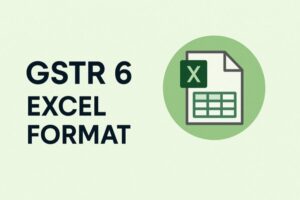Cash Sale Limit Under GST/Income Tax Act
- 1 Sep 24
- 8 mins
Cash Sale Limit Under GST/Income Tax Act
Key Takeaways
- Cash transactions exceeding ₹2 lakh per day are prohibited under Section 269ST of the Income Tax Act.
- Section 40A(3) limits cash expenditure to ₹10,000, disallowing any excess as a tax-deductible expense.
- Section 43 excludes expenses over ₹10,000 in cash for asset acquisition from the actual cost calculation.
- Section 269SS prohibits accepting loans or deposits over ₹20,000 in cash, with certain exemptions for government entities and banks.
- Non-compliance with cash transaction limits can result in penalties equal to the transaction amount under Sections 271DA and 271E.
The cash sale limit in GST refers to the cash transaction limit permitted under various sections of the Income Tax Act, including Sections 40A(3), 43 and 269SS. Non-compliance with these limits can result in penalties. Explore the cash sale limits under GST and the Income Tax Act, and learn about the entities and individuals for whom these limits do not apply, to make well-informed decisions.
Handle all your sales and purchase invoices in one place.
Pice’s all-in-one invoice management tool helps you track, send, and organize invoices from a single dashboard. Automatically share new invoices with customers, send timely payment reminders, and keep your collections under control—effortlessly.
Want early access? Fill out this form to get request a demo!
Cash Transaction Limit in India – Section 269ST
To restrain black money, the Finance Act 2017 included a new Section 269ST. This section limits the cash transactions or cash sale limit in GST on a particular day. The section imposes restrictions on cash receipts from entities or persons. It sets the transaction limit on cash sale not exceeding ₹2 lakh per day. This Section of the Income Tax Act further states that no person shall receive an amount exceeding ₹2 lakh in
- Aggregate from a single person per day
- A single transaction
- Respect of transactions relating to a single event from a person.
However, as per the guidelines of the Central Board of Direct Taxes (CBDT), the cash withdrawal limits do not apply to banks and post offices. As a result, the provision of Section 269ST does not apply to the following transactions:
- Cash received through bank transactions such as account payee cheque, account payee bank draft and electronic clearing system (ECS)
- Receipts by government, banks, post office savings bank or co-operative bank
- Transactions mentioned in Section 269SS
- Class of persons as official Gazette by the Central Government
Withdrawal from the Post Office
The withdrawal from the post office has certain guidelines. Here are the guidelines for withdrawal from the post office:
- Post offices under the India Post Department offer withdrawals from savings accounts with ATM facility.
- In a single day, you can withdraw ₹25,000 from a savings account or ATM with a limit of ₹10,000 per transaction.
- The post office allows 5 charge-free financial and non-financial (balance enquiry, statement request) transactions every month. In case you exceed the limit, they charge ₹20 exclusive of GST.
- Post offices further allow withdrawal from other bank ATMs wherein you can avail 3 free transactions in a metro city and 5 free transactions in a non-metro region. Once you exceed the limit, a charge of ₹20 and GST applies.
Withdrawal from Banks
You can withdraw the deposited amount from both your savings and current account with a bank using a chequebook, ATM machine and debit card. The withdrawal limit differs from bank to bank based on the type of debit card you are using. However, in the majority of the banks, the withdrawal limit ranges between ₹10,000 to ₹50,000 per day.
Cash Transaction Limit under Income Tax
The cash transaction limit under Income tax varies based on the section of the Act. Here are the limits for the 3 core sections of the Income Tax Act:
Section 40A(3) of Income Tax
Section 40A(3) of the Income Tax Act sets the cash transaction limit for expenditure at ₹10,000. Any expenditure in respect to cash payment beyond the amount is considered disallowed under the Income Tax Act. As a result, taxpayers need to choose alternative transaction modes such as debit cards, account transfers, cheques or demand drafts.
Section 43 of Income Tax
Under Section 43 of the Income Tax Act, if a taxpayer pays cash in excess of ₹10,000 to acquire an asset, that expense will be ignored when determining the actual cost of the asset. As a result, taxpayers should pay for asset acquisition using other bank channels.
Section 269SS of Income Tax
Section 269SS prohibits taxpayers from accepting loans, deposits and a sum of money exceeding ₹20,000 in cash. As a result, any loan amount exceeding ₹20,000 should be taken through other bank channels.
However, there are certain persons or entities where SEction 269SS does not apply. Here are the individuals and entities where it does not apply:
- Government
- Banking company, post office savings bank or cooperative bank
- Corporation established by a Central, State or Provincial Act
- Government company under clause (45) of Section 2 of the Companies Act 2013
- An institution, association, body or class of institution notified by the Central Government in the official gazette
- The person or entity from whom the loan or deposit is taken has agricultural income
- Person or entity who has non-taxable income under the Income Tax Act
Penalty Under Section 269SS

If a person or entity fails to comply with the provisions of Section 269SS, a penalty will apply equal to the loan or deposit amount or specified sum accepted.
Penalty Under Section 269ST
Under Section 271DA, if a person or entity fails to comply with the provisions of Section 269ST, a penalty will apply equal to the amount of receipt payable.
Section 269T of the Income Tax Act
Section 269T states that any bank, co-operative society, firm, or individual cannot repay a loan or deposit of ₹20,000 or more (including interest) in cash. Repayment must be made by an account payee cheque or bank draft in the name of the person who made the loan or deposit. This rule also applies if the total loans or deposits held by the person, alone or jointly, amount to ₹20,000 or more on the repayment date.
The provisions of this section however do not apply to the following persons or entities:
- Government
- Banking company, post office savings bank or cooperative banks
- Corporation established by a Central, State or Provincial Act
- Government company under clause (45) of Section 2 of the Companies Act 2013
- An institution, association, body or class of institution notified by the Central Government in the official gazette
Penalty Under Section 269T
Under Section 271E, a failure to comply with provisions of Section 269T leads to a penalty amount equal to the loan amount payable.
Conclusion
The cash sale limit in GST depends on the specific section of the Income Tax Act. Generally, the cash transaction limit is between ₹10,000 and ₹20,000 under Sections 40A(3), 43, and 269SS. However, government entities, banks, and post offices are exempt from these provisions. Ensure compliance with these sections regarding the cash sale limit in GST to avoid penalties.
💡If you want to pay your GST with Credit Card, then download Pice Business Payment App. Pice is the one stop app for paying all your business expenses.
 By
By 
















